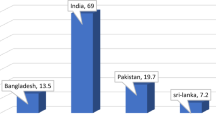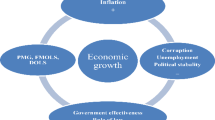Abstract
Although refugee resettlement remains a controversial issue, no attempt has yet been made to investigate the relationship between refugee inflow and crime rates in the United States, based on bounds testing approach to cointegration analysis with structural breaks. We argue that the first significant crime drop in the United States occurred prior to the 1990s—from 1980 to 1984—a period that witnessed a decline in refugee inflows following the enactment of the Refugee Act of 1980. We next investigate the sensitivity of total crime rate, violent crime rate, property crime rate and their sub-categories, namely, murder, rape, robbery, aggravated assault, burglary, larceny, and motor vehicle theft to an increase in refugee inflow (% of total population) in the United States, controlling for socioeconomic and demographic factors. The results strongly support the hypothesis that refugee inflow (% of total population) increases crime rates in all ten crime categories under study. The results further suggest that government policies aimed at reducing unemployment rate and income inequality, and an increase in federal expenditures on police force for maintaining public order and safety (% of GDP) will most likely reduce crime rates when there is an increase in refugee inflow (% of total population).



Similar content being viewed by others
References
Allen, R. C. (1996). Socioeconomic conditions and property crime: A comprehensive review and test of the professional literature. American Journal of Economics and Sociology, 55(3), 293–308.
Amuedo-Dorantes, C., Bansak, C., & Pozo, S. (2018). Refugee admissions and public safety: Are refugee settlement areas more prone to crime? International Migration Review, 55(1),135–165. https://doi.org/10.1177/0197918320920192
Ardino, V. (2012). Offending behaviour: The role of trauma and PTSD. European Journal of Psychotraumatology. https://doi.org/10.3402/ejpt.v3i0.18968
Bai, J., & Perron, P. (1998). Estimating and testing linear models with multiple structural changes. Econometrica, 66(1), 47–78.
Bai, J., & Perron, P. (2003). Computation and analysis of multiple structural change models. Journal of Applied Econometrics, 18, 1–22.
Becker, G. S. (1968). Crime and punishment: An economic approach. The Journal of Political Economy, 76(2), 169–217.
Bell, B., Fasani, F., & Machin, S. (2013). Crime and immigration: Evidence from large immigrant waves. Review of Economics and Statistics, 95(4), 1278–1290.
Bharadwaj, A. (2014). Is poverty the mother of crime? Empirical evidence of the impact of socioeconomic factors on crime in India, Atlantic Review of Economics, Colegio de Economistas de A Coruña, A Coruña, vol. 1.
Blau, J. R., & Blau, P. M. (1982). Cost of inequality: Metropolitan structure and violent crime. American Sociological Review, 47(1), 114–129.
Braithwaite, J. (1979). Inequality, crime and public policy. Routledge.
Carr-Hill, R. A., & Stern, N. H. (1973). An econometric model of the supply and control of recorded offenses in England and Wales. Journal of Public Economics, 2(4), 289–318.
Couttenier, M., Petrencu, V., Rohner, D., & Thoenig, M. (2019). The violent legacy of conflict: Evidence on asylum seekers, crime, and public policy in Switzerland. American Economic Review, 109(12), 4378–4425.
Danziger, S., & Wheeler, D. (1975). The economics of crime: Punishment or income redistribution. Review of Social Economy, 33(2), 113–131.
DeFranzo, J. (1996). Welfare and burglary. Crime and Delinquency, 42(2), 223–230.
DeFranzo, J. (1997). Welfare and homicide. Journal of Research in Crime and Delinquency, 34, 395–406.
DeFronzo, J. (1983). Economic assistance to impoverished Americans. Criminology, 21(1), 119–136.
Dehos, F. T. (2017). The refugee wave to Germany and its impact on crime (No. 737). Ruhr Economic Papers, RWI—Leibniz-Institut für Wirtschaftsforschung, Ruhr-University Bochum, TU Dortmund University, University of Duisburg-Essen.
Dobkin, C., & Puller, S. L. (2007). The effects of government transfers on monthly cycles in drug abuse, hospitalization and mortality. Journal of Public Economics, 91(11–12), 2137–2157.
Entorf, H., & Spengler, H. (2000). Socioeconomic and demographic factors of crime in Germany: evidence from panel data of the German states. International Review of Law and Economics, 20(1), 75–106.
Fajnzylber, P., Lederman, D., & Loayza, N. (2002a). What causes violent crime? European Economic Review, 46(7), 1323–1357.
Fajnzylber, P., Lederman, D., & Loayza, N. (2002b). Inequality and violent crime. Journal of Law and Economics, 45(1), 1–40.
Fergusson, D., & Lynskey, M. (1997). Physical punishment/maltreatment during childhood and adjustment in young adulthood. Childhood Abuse and Neglect, 21(7), 617–630.
Gehrsitz, M., & Ungerer, M. (2017). Jobs, crime, and votes: A short-run evaluation of the refugee crisis in Germany. Economica, 89(355), 592–626. https://doi.org/10.1111/ecca.12420.
Hangartner, D., Dinas, E., Marbach, M., Matakos, K., & Xefteris, D. (2019). Does exposure to the refugee crisis make natives more hostile? American Political Science Review, 113(2), 442–455.
Hannon, L., & DeFranzo, J. (1998a). Welfare and property crime. Justice Quarterly, 15(2), 273–287.
Hannon, L., & DeFranzo, J. (1998b). The truly disadvantaged, public assistance, and crime. Social Problems, 45(3), 383–392.
Howsen, R. M., & Jarrell, S. B. (1987). Some determinants of property crime: Economic factors influence criminal behavior but cannot completely explain the syndrome. American Journal of Economics and Sociology, 46(4), 445–457.
Huang, Y., & Kvasnicka, M. (2019). Immigration and crimes against natives: The 2015 refugee crisis in Germany. IZA Discussion Paper No. 12469. https://doi.org/10.2139/ssrn.3427607.
Hunt, J. (2006). Do teen births keep American crime high? The Journal of Law & Economics, 49(2), 533–566.
Jacobs, D. (1981). Inequality & economic crime. Sociology and Social Research, 66(1), 12–28.
Kayaoglu, A. (2021) Do refugees cause crime?. Economic Research Forum Working Paper No. 1470. Economic Research Forum, Istanbul Technical University, Turkey.
Kratcoski, P. C. (2016). Trends in criminality and victimization of the elderly. Federal Probation, 80(1), 58–63.
Lange, M., & Sommerfeld, K. (2018). Causal effects of immigration on crime: Quasi-experimental evidence from a large inflow of asylum seekers. Working Paper.
Levitt, S. (1999). The limited role of changing age structure in explaining aggregate crime rates. Criminology, 37(3), 581–597.
Levitt, S. D. (2004). Understanding why crime fell in the 1990s: Four Factors that explain the decline and six that do not. Journal of Economic Perspectives, 18(1), 163–190.
Liu, J., Wu, S., & Zidek, J. V. (1997). On segmented multivariate regression. Statistica Sinica, 7, 497–525.
Marbach, M., & Ropers, G. (2018). Not in MyBackyard: Do increases in immigration cause political violence?. IPL Working Paper 18-02. https://doi.org/10.2139/ssrn.3310352.
Masterson, D., & Yasenov, Y. (2021). Does halting refugee resettlement reduce crime? Evidence from the US refugee ban. American Political Science Review, 115(3), 1066–1073.
McCall, L. P., Parker, K. F., & MacDonald, J. M. (2008). The dynamic relationship between homicide rates and social, economic, and political factors from 1970 to 2000. Social Science Research, 37(3), 721–735.
Müller, K, & Schwarz, C. (2021). Fanning the flames of hate: Social media and hate crime. Journal of the European Economic Association, 19(4), 2131–2167. https://doi.org/10.1093/jeea/jvaa045.
Narayan, P. K., & Smyth, R. (2004). Crime rates, male youth unemployment and real income in Australia: Evidence from Granger causality tests. Applied Economics, 36(18), 2079–2095.
Neumayer, E. (2005). Inequality and violent crime: Evidence from data on robbery and violent theft. Journal of Peace Research, 42, 101–112.
Northrup, B., & Klaer, J. (2014). Effects of GDP on violent crime. Working paper, Georgie Tech Library. https://smartech.gatech.edu/handle/1853/51649.
Okpokwasili, B. C. I. (2005). Income inequality: Impact of inequality measures on crimes an analysis of the state of New Jersey. International Journal of Business and Social Research, 6(4), 12–27.
Ousey, G. C., & Kubrin, C. E. (2009). Exploring the connection between immigration and violent crime rates in US cities, 1980–2000. Social Problems, 56(3), 447–473.
Parker, K. F., Mancik, A., & Stansfield, R. (2017). American crime drops: Investigating the breaks, dips and drops in temporal homicide. Social Science Research, 64, 154–170.
Patterson, E. B. (1991). Poverty, income inequality and community crime rates. Criminology, 29(4), 755–776.
Pesaran, M. H., Shin, Y., & Smith, R. J. (2001). Bounds testing approaches to the analysis of level relationships. Journal of Applied Econometrics, 16(3), 289–326.
Raphael, S., & Winter-Ebmer, R. (2001). Identifying the effect of unemployment on crime. The Journal of Law & Economics, 44(1), 259–283.
Sen, A. (2007). Does increased abortion lead to lower crime? Evaluating the relationship between crime, abortion and fertility. The B.E. Journal of Economic Analysis & Policy. https://doi.org/10.2202/1935-1682.1537.
Sjoquist, D. L. (1973). Property crime and economic behavior: Some empirical results. American Economic Review, 63(3), 439–446.
Weinberg, B. (2002).Crime conundrum. The New Republic. https://newrepublic.com/article/80316/relationship-poverty-crime-rates-economic-conditions.
Zimring, F. E. (2007). The great American crime decline. Oxford University Press.
Zivot, E., & Andrews, D.K.W. (1992). Further evidence of great crash, the oil price shock and unit root hypothesis. Journal of Business and Economic Statistics, 10(3), 251–270.
Author information
Authors and Affiliations
Corresponding author
Additional information
Publisher's Note
Springer Nature remains neutral with regard to jurisdictional claims in published maps and institutional affiliations.
Rights and permissions
Springer Nature or its licensor holds exclusive rights to this article under a publishing agreement with the author(s) or other rightsholder(s); author self-archiving of the accepted manuscript version of this article is solely governed by the terms of such publishing agreement and applicable law.
About this article
Cite this article
Thasinul Abedin, M., Mitra, R. & Sen, K.K. Does Refugee Inflow Increase Crime Rates in the United States?. Soc Indic Res 164, 1379–1401 (2022). https://doi.org/10.1007/s11205-022-02996-5
Accepted:
Published:
Issue Date:
DOI: https://doi.org/10.1007/s11205-022-02996-5




